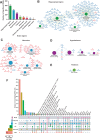Spatial transcriptomics reveals unique gene expression changes in different brain regions after sleep deprivation
- PMID: 37925446
- PMCID: PMC10625558
- DOI: 10.1038/s41467-023-42751-z
Spatial transcriptomics reveals unique gene expression changes in different brain regions after sleep deprivation
Abstract
Sleep deprivation has far-reaching consequences on the brain and behavior, impacting memory, attention, and metabolism. Previous research has focused on gene expression changes in individual brain regions, such as the hippocampus or cortex. Therefore, it is unclear how uniformly or heterogeneously sleep loss affects the brain. Here, we use spatial transcriptomics to define the impact of a brief period of sleep deprivation across the brain in male mice. We find that sleep deprivation induced pronounced differences in gene expression across the brain, with the greatest changes in the hippocampus, neocortex, hypothalamus, and thalamus. Both the differentially expressed genes and the direction of regulation differed markedly across regions. Importantly, we developed bioinformatic tools to register tissue sections and gene expression data into a common anatomical space, allowing a brain-wide comparison of gene expression patterns between samples. Our results suggest that distinct molecular mechanisms acting in discrete brain regions underlie the biological effects of sleep deprivation.
© 2023. The Author(s).
Conflict of interest statement
T.A. serves on the Scientific Advisory Board of EmbarkNeuro and is a scientific advisor to Aditum Bio and Radius Health. The other authors declare no conflicting interests.
Figures





Update of
-
Spatial transcriptomics reveals unique gene expression changes in different brain regions after sleep deprivation.bioRxiv [Preprint]. 2023 Jan 19:2023.01.18.524406. doi: 10.1101/2023.01.18.524406. bioRxiv. 2023. Update in: Nat Commun. 2023 Nov 4;14(1):7095. doi: 10.1038/s41467-023-42751-z. PMID: 36712009 Free PMC article. Updated. Preprint.
References
Publication types
MeSH terms
Grants and funding
LinkOut - more resources
Full Text Sources
Molecular Biology Databases

